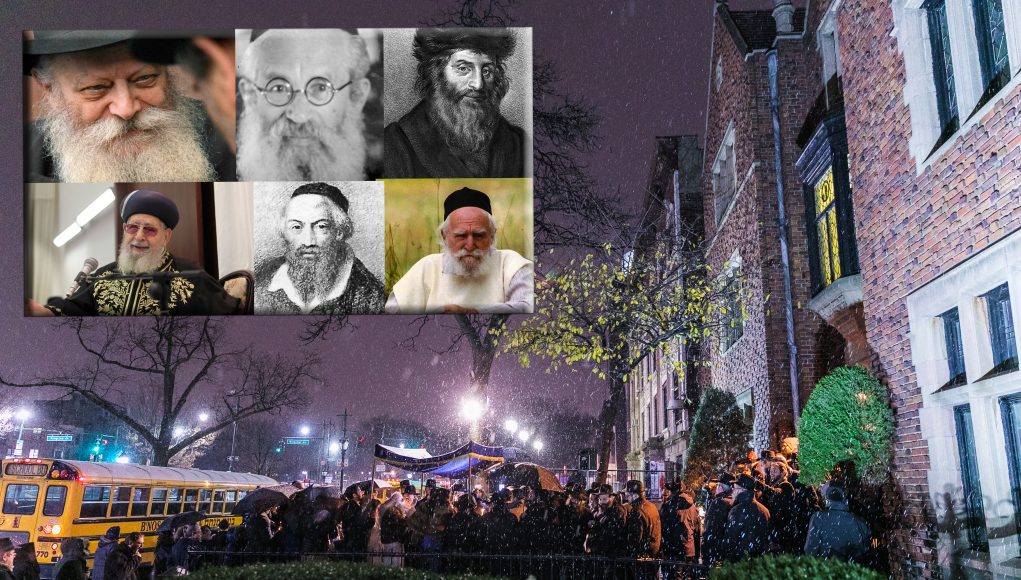 Credit photo: Meir Pliskin Photogrpahy
Credit photo: Meir Pliskin Photogrpahy
Compiled by Rabbi Avrohom Tsvi Black
Our Sages have hotly debated this question, which is extremely interesting.
The Remoh (Even HoEzer, 61:1) tells us that, “There are authorities who rule that we should make a Chupah beneath the sky as a “Siman Tov”, a good sign that the couple’s descendants should be numerous, just like the stars in the sky.” (1)
Well, that tells us that there are authorities whom we can rely upon if we want to get married outdoors, but do we have to? What happens if we live in Alaska? Is this mandatory, or merely recommended?
Please bear with me as we explore this subject.
The Chasam Sofer (Even HoEzer, 1:98) was asked whether it is right to make a Chupah in a Shul as people once did, as a Shul is a holy place.
To answer, the Chasam Sofer quotes the Maharam Mintz (119) at length. The Maharam Mintz infers that it used to be customary to have a Chupah in a Shul (with or without a gap in the roof so that the couple will be beneath the sky). This custom indicates that the couple will have descendants as numerous as the stars in the sky. It is similar to other customs that we do during a Chupah, such as holding candles, which indicate light and joy, and throwing wheat kernels on the couple, which indicates that they should be fruitful and multiply.
The Chasam Sofer also writes that the Maharil was accustomed to making Chupahs for widows in Shul courtyards, whereas first marriages would be made indoors.
Nevertheless, Ashkenazi customs were originally established by Rashi, Baalei HaTosfos and their followers, who all lived in Ashkenaz (Germany and its surrounding countries). They considered it commendable to indicate that a couple would merit Avrohom’s Brochoh for his descendants, as Hakodosh Boruch Hu blessed him (Bereishis, 16:5) with seed like stars. Hakodosh Boruch Hu also told Avrohom to go outside to the stars, so to speak, so that the Brochoh would be validated.
We should also do the same thing when appropriate and get married beneath the sky, and do this in a holy place where people pray regularly. Thus, the custom became to begin the Chupah beneath the sky for its Brochoh, and the rest of the Chupah and Brochos would be made in a Shul, at the Bimah. This was only for a primary marriage, as a widow would have her entire Chupah beneath the sky, this Brochoh of the stars being the most important.
The Remoh based his ruling on this source. In Poland and Russia, though, they never used to make a Chupah indoors, and it is also far better to make a Chupah in a Shul courtyard.
The Ashkenazi custom in the Chasam Sofer’s time, though, was not to make a Chupah in a Shul, perhaps because Shuls didn’t have corridors in front of them, and people would often pray in Shul courtyards (thereby making them holy places where people prayed regularly).
The Chasam Sofer concludes that if we want to do without our Brochoh, to learn from other nations that don’t get the Brochoh of the stars, but get married in churches, then we can be like them if we so choose. If we choose to get the Brochoh that our Fathers got, however, then our descendants will be like our Fathers, and be fruitful.
Let’s look at some modern authorities.
Rabbi Herzog, a former Chief Rabbi of Israel, points out (Heichal Yitschak, Even HoEzer, 2:27) that Jews in Lithuania and other countries ruled by Russia were all accustomed to making Chupahs beneath the sky, usually in a Shul courtyard or nearby.
In England, though, they would get married in Shul, which Rabbi Herzog did not feel comfortable with, but could not change, as this was already an established custom. In Israel, however, where they are not accustomed to doing this, both Ashkenazim and Sephardim (who get married indoors) should not make innovations and get married in a Shul.
There are good reasons for this. Rabbi Herzog points out that we are not even allowed to kiss small children in Shul, and kissing is bound to happen if we have a Chupah in Shul, and not just the couple getting married. This can be between all sorts of people, and lead to serious transgressions, such as Arayos and Niddah, all in Shul, which is supposed to be for serving Hakodosh Boruch Hu. We should obviously object to such changes. It would be far better to build something small in a Shul courtyard, either without a roof or with a removable roof for Ashkenazim, or with a roof for Sephardim, as they are not accustomed to getting married beneath the sky.
Rav Moshe Feinstein, though, looks at this subject a little more leniently. He writes (Igros Moshe, Even HoEzer, 93) that making a Chupah beneath the sky is only a custom for the sake of a Brochoh, and is not a rabbinical obligation. In fact, this custom was not established because of a Halochoh, a prohibition or a Mitzvah, so we would not be transgressing anything if we were to do otherwise. It is no different from the Rabbinical Brochoh to get married on Wednesday so that a marriage will be consummated on Thursday, and the Gemorrah tells us that we are not transgressing anything if we forgo that Brochoh. The same reasoning applies to the Shulchan Oruch’s recommendation (Yoreh Deah, 179) that we get married at the beginning of a month. Very few people keep this in mind, and they are certainly not transgressing anything by not doing so. These things are simply recommendations, especially customs that have no basis from Chazal.
Even the Chasam Sofer never said that this is forbidden, unless we want to mimic non-Jews. Even then, this is not forbidden, but is indicative that we do not want the Brochoh. Our Sages do not like these things either, but they are not forbidden.
What the Chasam Sofer wrote also has to be taken in the context of his time and place. The Reform movement was extant at the time, and they wanted to uproot Jewish customs and Torah principles. This is why they wanted to make Chupahs in Shul, and to change the established custom of getting married beneath the sky. (2) If people want to get married otherwise without having the Reform practice in mind, then there is no problem in doing so, just as there is no problem in getting married at the end of a month.
It is not even a problem to get married in a Shul, though many gentiles get married in church. A Shul is our place of worship, not theirs, and our prayers make the difference. We also see that we used to get married in a Shul at one point, as the Chasam Sofer himself points out.
Rabbi Ovadiah Yosef (Yebiah Omer 3, Even HoEzer, 10) rules that this is only forbidden if somebody wants to behave like a non-Jew, or if there will be a problem of modesty or suchlike. Not only that, but who says that gentiles were accustomed to insisting on only getting married in a church in the Maharil’s time and place?
Nevertheless, the Magen Avrohom (Orach Chaim, 68) quotes the Yerushalmi as saying that customs are established for a reason, and that we should not change them, especially if this differentiates us from non-Jews. We should stick to our own customs and not copy others. However, there is a custom to get married in a holy place, where people generally pray. Everything depends on what we have in mind- the holiness of a place or copying non-Jews.
In the letters of correspondence with the Lubavitcher Rebbe he writes:
.. With regard to that which you write about having the chuppah under the heavens: Since this custom is cited in many places and there are many reasons for it, I strongly hope that all will agree to do so, which is to say, that the chuppah will take place under the stars. Even when the wedding takes place in a hall that has no opening in the roof, the chuppah can be outside and close to the hall. May you be blessed “like the stars in the heavens,” (which is also one of the reasons for having the chuppah under the stars). (Igros Kodesh, Vol. XIX, p. 413)
In another letter….
Thank you for your article about opposition to compromises …. However, your inclusion therein of a chuppah that takes place in a hall which has an opening in the roof requires to be understood, inasmuch as this is not a compromise, but rather fulfills the requirement [of having a chuppah under the heavens] in its totality. (Igros Kodesh, Vol. XII, p. 117)
Keeping all this in mind and focusing back on our original questions, we can now view them from a different perspective.
A couple getting married can certainly get married outdoors beneath the sky. Some people would love to get married in a park. From a Halachic point of view, that would not be a problem, but it would be better if they chose somewhere close to a Shul.
As Rabbi Herzog points out, there are problems getting married in a Shul. This custom was originally done a long time ago, but was generally replaced by the custom of getting married beneath the sky. This was not the case in England and Germany, and both customs are apparently practiced in the United States. One problem with getting married in a Shul is that this custom was encouraged by the Reform movement, and it would therefore be forbidden to do so because that is the way Reform Jews get married.
What happens, though, if a couple wants to get married in Alaska, or in Manchester, where it rains all the time? Rav Ovadiah Yosef points out that they can’t get married when they are getting soaked, or if the wind is blowing the Chupah away! It is certainly not forbidden to get married indoors under such circumstances, and that is presumably why they do so in many parts of Europe. However, our couple has to make sure that men and women observe Tsnius and other proprieties. Otherwise, they have a serious problem.
Interestingly, people in Israel do not usually get married in a Shul or anywhere near one. They usually choose a hall or hotel.
In conclusion, it is not a halachic issue here, but rather a hashkafic one. If we want to gain a brochoh of inestimable value, then it is well worth getting married under the sky. In fact, prior to the Rishonim, the custom in Europe was to make a “Chupas Mainz,” where the beginning of the chupah was in the Shul courtyard, and the rest was in the Shul. Our Rishonim decided to change this custom, to gain this special brochoh, and so the custom changed in what was then Imperial Russia.
As a rule of thumb, however, it is always best to ask your Rabbi, as so much depends on where a couple wants to get married, and on the circumstances and local customs.
(1) – The Remoh puts it like this; – יש אומרים לעשות החופה תחת השמים, לסימן טוב שיהא זרעם ככוכבי השמים.
(2) I also heard in the name of somebody from Pressburg that another reason to avoid making Chupahs in a Shul was because there was a custom to dance after a Chupah, and women would come dressed to do so, which was not always appropriate for a Shul.












